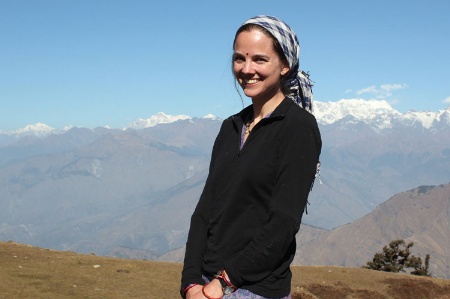Source: Jane Dyson
Having those really strong relationships means that I can ask all sorts of questions and be with people in a way I just couldn’t otherwise
“You are living in a tiny, one-room house mainly taken up by cattle, sitting round a fire with no ventilation or chimney. It’s very smoky. In the day it’s cold and incredibly physically active, so I’d get ill and constantly have a cold.”
Jane Dyson, now a research associate in the School of Geography and the Environment at the University of Oxford, is describing the 15 months in 2003-04 she spent in a Himalayan village that she calls by the pseudonym “Bemni” – located in three separate settlements between 2,200 and 2,800 metres above sea level. Although this formed the basis for her remarkable recent book, Working Childhoods: Youth, Agency and the Environment in India, the combination of altitude, terrain and back-breaking labour left her “constantly exhausted”.
To find out about the lives of busy children and adolescents who were “just not used to being asked their opinions by adults”, Dyson observed and chatted with them while they were out herding cattle and collecting leaves and lichen. Yet it proved very demanding, she says, to “cut the crops and forest products by hand and haul them on your back up and down the slopes” all the way back to the village.
It was not unusual for her to slide down the steep gradients while collecting the leaves. Furthermore, Dyson recalls, “you had to be hyper-vigilant”, as there were occasional stories of people being killed by bears and “I had a report of a leopard attack pretty much every day. I’d go out and clean my teeth at night and you’d hear a leopard really close by. The dog on a neighbour’s roof 10 metres away was attacked by a leopard. I never saw either a leopard or a bear, but all the dogs were wearing huge metal collars with spikes.”
Since there was “a tap, but no latrine or private washing space”, Dyson writes, “the process of getting going in the morning – going to the lavatory in a secluded field, heating water to wash hands and face, washing up the previous night’s dishes, cooking breakfast over a paraffin stove and washing up again – could take two to three hours”. Regular trips to the local district town proved pretty much essential for getting rid of bedbugs as well as typing up her notes. One of the few “luxuries” she insisted on was a sleeping bag, although a disgusted old woman asked her “What happens to your farts?”
Unsurprisingly, perhaps, such a life took a severe toll on Dyson’s health, with colds developing into the chronic sinusitis that eventually landed her in a Delhi hospital, where a surgeon declared “Your days in the Himalayas have rapidly come to an end.” This only spurred her to return to her fieldwork, although she also made a brief trip back to England for an operation.
So why did Dyson put herself through such an ordeal and even return to Bemni for further periods of about nine months in all – including four months living there with her husband and small children – as part of a larger research project looking at the politics of educated unemployed youth in India, Sri Lanka and Nepal?

After studying zoology at the University of Edinburgh, Dyson worked with a national park and rural communities in Senegal, Ethiopia and Guinea on environmental education programmes. She wrote a children’s book on ecological themes, which was tested in villages and given to teachers with guidance on how to use it. She carried out “elephant-based research in Zimbabwe, looking at conflict with local people, the movement of the elephants, crop-raiding patterns and how to mitigate them” and used this material to obtain a research master’s from Edinburgh. She then moved on to a shorter project in India, learned Hindi and applied to the University of Cambridge to do a PhD.
“I had been reading about natural-resource management, including forests in the Himalayas,” Dyson explains. Although researchers had begun to devote more attention to women, what was “completely missing from the literature” was “the whole idea of young people being key players in agricultural and natural-resource management”. Yet she had already worked extensively with children – they often knew most about elephant movements in Zimbabwe, as they were the ones herding the cattle – and “had become increasingly frustrated by the lack of acknowledgement of the role of children. The impetus for the PhD was to look at children’s role.”
From the outside, gender distinctions in the villages of the upper Himalayas appear to be highly restrictive. (Dyson’s book describes how she tried to fit in by “remaining relatively demure in public settings and avoiding public discussions with men”. She also took on a female research assistant simply because “it was considered odd for a young woman to be seen ‘wandering around’ alone”.) There is little sign of the open rebellion against parental and communal norms familiar among Western adolescents. But although these points remain broadly true, Dyson’s detailed, long-term ethnographic research based on close personal contacts enabled her to paint a far more complex picture.
When she first arrived in Bemni, as she tells us in Working Childhoods, the head of the local forest committee – and de facto leader of the village – came to the house where she was staying and, despite her explaining that she wanted to work with young people, “sought to lay claim over me immediately, and loudly discussed my schedule the next day with the assembled group of men”. A 16-year-old girl called Saka took no part in the discussion and just continued cooking bread.
The next morning, however, before the men were even up, Saka asked Dyson to accompany her and her friends for a day’s work in the forest. It was while working and over lunches of flatbread, vegetables and sometimes “mountain ice cream” – ground chilli and coriander mixed into handfuls of snow – that she acquired a much richer sense of the lives of “these very demure young women who suddenly become loud, tell lewd jokes and have very explicit conversations you would never expect if you saw them in the village. There were lots of conversations with the younger girls about what sort of husbands they wanted.” She also reports examples of “carnivalesque misdemeanours” such as snowball fights, mock battles, jeering songs and a practical joke involving a girl urinating from a tree on her sister.
In many ways, Dyson greatly enjoyed this atmosphere of “lots of teasing, which I find a comfortable way to be, and I have to check myself when I come back here [to Oxford]”. Yet the very fact that girls “had to climb 1,000 metres or so in the depths of winter to obtain opportunities for unchaperoned ‘fun’,” her book reflects ruefully, “says much about the scale of gender inequality in Bemni”.

Academics have long discussed child labour and the value (or otherwise) of education within isolated and impoverished rural communities. They have reflected on the nature of friendships within such societies, and how far they are just opportunistic or forged through joint activities. And they have analysed how young people manage to express “agency” even while largely conforming to social norms. Dyson’s fine-grained approach allows her to offer fresh perspectives on all these debates. It also provided her with an understanding of the context and a sort of baseline, as her child informants have turned into adults, for tracking the impact of the many changes that Bemni has gone through during the past decade.
The village is now accessible by road or rather dirt track; there is irregular electricity, or at least light, and a telecommunications tower for mobile phones; the number of latrines and very basic bathrooms is increasing. Even more significant, educational opportunities have been greatly extended, with government regulations making schooling obligatory for children aged 6 to 14, and with many continuing to the equivalent of A levels and even degrees. Girls have gone on to become teaching assistants or auxiliary nurses, while one has even secured a permanent government teaching position in a nearby village.
All this has transformed life in Bemni in a single generation, notes Dyson, as “young people start to acquire BAs and MAs, though their parents can’t even sign their names”. While a few actually go away to attend university on a residential basis, most just sign up, study in private and turn up for a week to take exams – an experience that can prove “hugely eye-opening and empowering” for girls who otherwise get few opportunities to see even their local town.
Some of the dilemmas faced by graduates are explored in Dyson’s recently completed 15-minute film Lifelines: A Portrait from the Himalayas through the story of a man called Makar Singh. With the women, however, she is beginning to recognise “all the conversations one might have here. The issue of how to juggle family and work is equally relevant there. There are new pressures on young educated women to start educating their small children or preparing them for school. That makes them think about bringing up their children in a different way, rather than just sending them off to work or abandoning them for long periods and going off to work themselves. Should they be spending more time teaching them the alphabet or keeping them clean instead?”
Despite the hardships – and the mockery she now has to endure for her parenting as well as her lichen-gathering skills – Dyson is clear that her deep immersion in Bemni has proved absolutely crucial to her research. “Having those really strong relationships means I can ask all sorts of questions and be with people in a way I just couldn’t otherwise.” More than that, however, she declares that she “can’t think of anything more fun than living in the village. I love it. They’ve become like my family. People joke that it’s my natal home, that I’m a daughter of the village, and that I’m coming back to Oxford to my marital home.”





